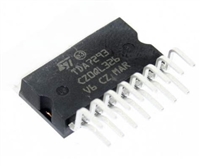ADT7483A
THEORY OF OPERATION
The ADT7483A is a local and 2x remote temperature sensor
and over/under temperature alarm. When the ADT7483A is
operating normally, the on-board ADC operates in a free-
running mode. The analog input multiplexer alternately selects
either the on-chip temperature sensor or one of the remote
temperature sensors to measure its local temperature. The ADC
digitizes these signals, and the results are stored in the local,
Remote 1, and Remote 2 temperature value registers.
emitter voltage (VBE) of a transistor, operated at constant
current. Unfortunately, this technique requires calibration to
null the effect of the absolute value of VBE, which varies from
device to device. The technique used in the ADT7483A is to
measure the change in VBE when the device is operated at two
different currents.
Figure 15 shows the input signal conditioning used to measure
the output of a remote temperature sensor. This figure shows
the remote sensor as a substrate transistor, but it could equally
be a discrete transistor. If a discrete transistor is used, the
collector is not grounded and should be linked to the base. To
prevent ground noise interfering with the measurement, the
more negative terminal of the sensor is not referenced to ground
but is biased above ground by an internal diode at the D− input.
C1 can be optionally added as a noise filter (recommended
maximum value 1,000 pF).
The local and remote measurement results are compared with
THERM
the corresponding high, low, and
temperature limits
stored in on-chip registers. Out-of-limit comparisons generate
flags that are stored in the status register. A result that exceeds
the high temperature limit, the low temperature limit, or a
ALERT
remote diode open circuit causes the
output to assert
temperature limits causes the
ALERT
THERM
output to assert low. The
low. Likewise, exceeding
THERM
output can be
output.
THERM
reprogrammed as a second
To measure ΔVBE, the operating current through the sensor is
switched among two related currents, I and N × I. The currents
through the temperature diode are switched between I and N × I,
giving ΔVBE. The temperature is then calculated using the ΔVBE
measurement.
The limit registers can be programmed, and the device
controlled and configured, via the serial SMBus. The contents
of any register can also be read back via the SMBus.
Control and configuration functions consist of:
The resulting ΔVBE waveforms pass through a 65 kHz low-pass
filter to remove noise and then to a chopper-stabilized
amplifier. This amplifies and rectifies the waveform to produce
a dc voltage proportional to ΔVBE. The ADC digitizes this
voltage and produces a temperature measurement. To reduce
the effects of noise, digital filtering is performed by averaging
the results of 16 measurement cycles for low conversion rates.
At rates of 16, 32, and 64 conversions/second, no digital
averaging takes place.
•
Switching the device between normal operation and
standby mode.
•
•
•
•
Selecting the temperature measurement scale.
ALERT
Masking or enabling the
Switching Pin 13 between
output.
ALERT THERM2
and
.
Selecting the conversion rate.
TEMPERATURE MEASUREMENT METHOD
Signal conditioning and measurement of the local temperature
sensor is performed in the same manner.
A simple method of measuring temperature is to exploit the
negative temperature coefficient of a diode, measuring the base-
V
DD
I
BIAS
I
N × I
V
OUT+
D+
1
TO ADC
C1
REMOTE
SENSING
TRANSISTOR
LPF
fC = 65kHz
D–
V
OUT–
BIAS
DIODE
1
CAPACITOR C1 IS OPTIONAL. IT IS ONLY NECESSARY IN NOISY ENVIRONMENTS. C1 = 1000pF MAX.
Figure 15. Input Signal Conditioning
Rev. 0 | Page 9 of 24






 ?TPA3116D2功放芯片参数详解、引脚说明
?TPA3116D2功放芯片参数详解、引脚说明

 74HC165引脚说明、驱动程序示例解读
74HC165引脚说明、驱动程序示例解读

 深入解析AD9833:DDS频率合成器的卓越性能与广泛应用
深入解析AD9833:DDS频率合成器的卓越性能与广泛应用

 高性能TDA7293音频功率放大器技术特性与应用分析
高性能TDA7293音频功率放大器技术特性与应用分析
